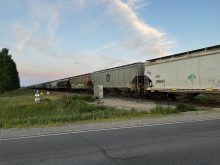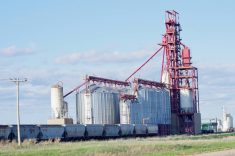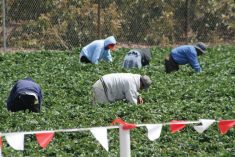They’re not besties yet — but the relationship between farm groups and the railways has undergone a sea change over the last few years.
After years of vociferous complaints about poor rail service, the federal government cracked the whip in 2014, ordering CP and CN Rail to move one million tonnes of grain weekly or face fines of $100,000 per day. When the order-in-council was renewed that summer, Alberta farm leaders travelled to Saskatoon to witness the announcement by then agriculture minister Gerry Ritz.
Read Also

Farming Smarter receives financial boost from Alberta government for potato research
Farming Smarter near Lethbridge got a boost to its research equipment, thanks to the Alberta government’s increase in funding for research associations.
Gary Stanford, then president of the Grain Growers of Canada, was one of those in attendance.
Things have changed significantly since then, said Stanford, who is now chair of Alberta Wheat.
“We are still working with the federal government and we’re working with the Ag Transport Coalition to make sure that grain is moving in a timely fashion,” he said. “It’s not as bad as it was when we had to put the order-in-council to make them move more grain.”
After record grain movement by both railways in the 2018-19 crop year, the Western Canadian Wheat Growers, another longtime critic, even issued a press release to “congratulate” CN and CP.

“We have improved relationships,” said Jeff Nielsen, who succeeded Stanford as Grain Growers president.
“Both railroads have stepped up their game and have tried to provide real-time information to producers, and work with producers a little bit better than they have in the past.”
While not a ringing endorsement, those sorts of comments are a far cry from what was being said during the winter of six years ago when the movement of a record Prairie grain crop slowed to a crawl, partly because of a harsh winter but also because of railway cutbacks.
“They decommissioned over 400 engines and laid off 4,500 staff,” recalled Nielsen. “With the shortage of power and shortage of manpower, both railroads were highly affected by winter, labour and car shortages.
“It amplified to the point where we had 58 vessels waiting for grain in Vancouver.”
While Ottawa’s actions proved to be a turning point, the biggest change has been that farm groups, grain companies, and the railways are now regularly talking to each other, said Stanford.
The topics of those conversations — such as the fact grain companies book sales months in advance or that demurrage costs for waiting ships can top $15,000 a day — aren’t revelatory, but it has made a big difference, said Stanford.
“I think it brought it to a new light,” he said. “The railways had become a little complacent because we were only growing a certain amount of grain. But now farmers don’t summerfallow anymore. We plant every acre, and with new plant varieties and the new farming technology we have, we have bigger yields each year.”
There were more backlogs in the winter of 2017-18, again in part because of harsh winter conditions that forced railways to shorten trains and go slower.
“There were some unfortunate incidents of rail issues with both rail lines before the winter hit again (that year),” said Nielsen. “It just compounded. Once you lose a day, a week or more when you’re handling grain, it takes two or three times longer to catch back up.”
But the situation wasn’t as grave as in 2013-14, he added.
“We had a few vessels in port, but not as many as before,” said Nielsen.
Moreover, it prompted another significant change — the railways created an advisory council that included representatives from major farming organizations, so they could get better feedback.
“The railways changed their attitude towards us,” said Stanford. “They invite us to more meetings and they are more open to come and have discussions with us.
“Now, if we set up meetings with CN or CP, they’re very open to us. It takes about a month to set the meetings up, but that’s fine. That part is better.”
The passage of Bill C-49 in 2018, which amended the Canada Transportation Act, also changed things for the better.
Grain groups got together and tried to ensure that a lot of the right changes were made, said Nielsen. Those included encouraging more investment by railways and making reciprocal financial penalties and dispute resolution part of arbitrated service level agreements.
“The senate came up with a lot of great recommendations,” said Nielsen. “Transportation Minister Marc Garneau said he wasn’t going to accept any of those recommendations and yet he bowed to pressure because a lot of those producer groups put their pressure on. It’s a shift in politics.”
Since then the rail companies have also invested heavily in new infrastructure, including new track and adding locomotives and rail cars. (CN, for example, is in the midst of buying 1,000 new high-capacity hopper cars.)
“There are a lot of efficiencies that we have seen come on since the passing of C-49,” said Nielsen.
But while there has been major changes, there’s more work to do, he added.
“It’s still a work in progress,” said Nielsen. “We’re learning to communicate with them better and we’re building lines of communication.
“We’re cautious about it. We’ve been burned in the past and we don’t want to do it again.”
















